5.
Paris: The Arts & Smarts Tour
Here, where the river gently winds through the girdle of hills, lies a soil so saturated with the past that however far back the mind roams one can never detach it from its human background.
- Henry Miller, Tropic of Cancer
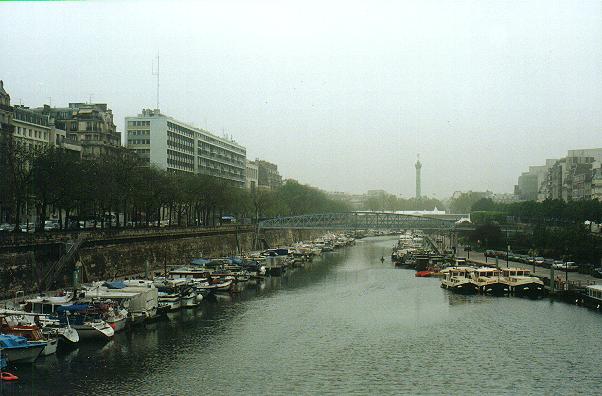
Tuesday morning it was cold and wet again, not raining but gray and overcast with a raw chilly wind out of the northeast that was not quite strong enough to dispel the thin fog that hung low over the city. Looking northward along the Porte de Plaisante from down by the river, the Bastille Monument was barely visible through the mist. So much for Paris in the spring.
I set out, all the same, to see what I could. I left my jacket in the room, having convinced myself that it would clear off and warm up in a few hours and then I'd have to lug the jacket around for the rest of the day. This was a reasonable assumption, since this had been the pattern for several days, in England and then in France. Unfortunately it was totally wrong...I wore nothing heavier than a thick flannel shirt, and spent most of the day chilled and shivery but too stubborn to go back to the hotel and get my jacket.
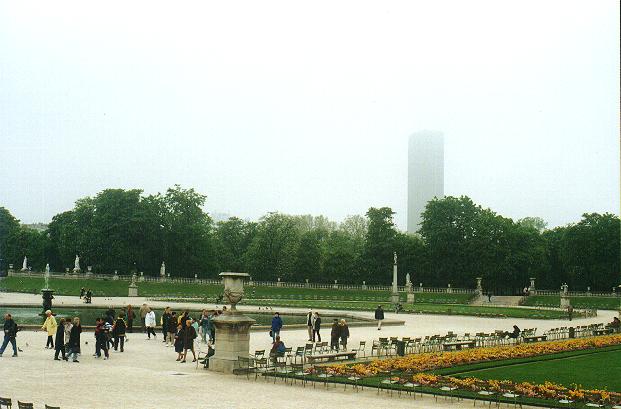 The Jardin du Luxembourg looked subdued and a little depressed in the gray light; its flower gardens gave the impression of wishing they hadn't bothered, like people who have gotten all dressed up for a party that turned out badly. On the other hand, the drifting fog did obscure the hideous shape of the Tour de Montparnasse, Paris's worst lapse of architectural taste in the last century. Why they didn't dust off the guillotine for those responsible, I cannot understand.
The Jardin du Luxembourg looked subdued and a little depressed in the gray light; its flower gardens gave the impression of wishing they hadn't bothered, like people who have gotten all dressed up for a party that turned out badly. On the other hand, the drifting fog did obscure the hideous shape of the Tour de Montparnasse, Paris's worst lapse of architectural taste in the last century. Why they didn't dust off the guillotine for those responsible, I cannot understand.
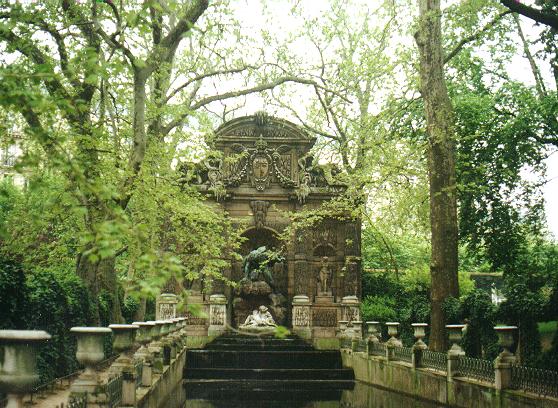
And the fog and the poor light did add a certain weird, haunted quality to the 17th-century Médici fountain. Appropriately so; that whole Médici business is weird, was weird even at the time.

Marie de Médici created the Palais du Luxembourg, and its surrounding gardens and fountains and the like, after the murder of her husband, Henri IV; but she never got to live there. Her son, Louis XIII, exiled her for opposing Cardinal Richelieu. Nice guy, Louis XIII, and an excellent proof of the fallacy of hereditary monarchy: by all historical evidence a thoroughly worthless shit, yet he was the son of the best king France ever had. The Palais now houses the French Senate, a body of almost wholly ceremonial authority.
That I was in the neighborhood of the Jardin du Luxembourg will tell the Paris-hip reader what I was doing. Yes; I was doing the Left Bank tour, or a piece of it.
May as well explain now: I have had a lifelong fascination with that period between the big wars, particularly the literary and cultural scene in Europe and especially Paris. Ernest Hemingway is one of my favorite authors - I consider him the greatest American writer of the twentieth century - and Henry Miller comes pretty close; between them, they managed to get Paris under my skin clear back when I was in college, and I never got over it. I have probably reread A Moveable Feast as many times as I have any single book, and despite the verdict of critics, I think it one of the best things Hemingway ever did. Those who disagree may bite me.
So for me this was in the nature of a pilgrimage. It was indeed one of the main reasons I had wanted to visit Paris in the first place.
I knew it wouldn't be the same, of course; I knew it wouldn't even be approximately similar, any more than Giuliani's New York resembles Dorothy Parker's, or today's cleaned-up-and-boring Monterey resembles Steinbeck's. But still, place is place.
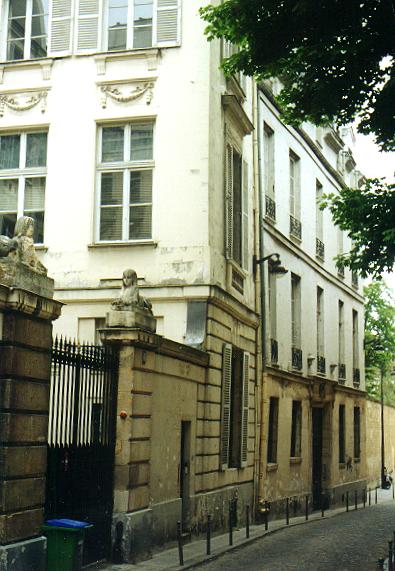
Here, for example, just a little way from the Palais du Luxembourg, is Number 6 Rue Ferou, where Hemingway lived for a time after leaving his first wife. This is where he worked on A Farewell To Arms. Man Ray lived up the street at Number 2, though I don't know if they were there at the same time.

And here, at 27 Rue de Fleurus, is where Gertrude Stein and her lover Alice Toklas lived and held their famous salons. This is where Hemingway - who was, at the time, something of a country boy in some respects - got a bad shock when he accidentally overheard an intimate exchange between the two.

Here is Number 70 Notre-Dame-des-Champs, Ezra Pound's place during the days before he went crazy; where Hemingway tried unsuccessfully to teach Pound to box.

And here we have the famous corner, on what is now the Place Pablo Picasso, at the intersection of the Boulevardes Raspail and Montparnasse. There was a time when the café scene hereabouts included some of the most incredible literary and artistic talents of the twentieth century - as well as some of the worst phonies, parasites, and all-around four-flushers. In some cases these categories overlapped.
The Café du Dôme, visible in this photo, features frequently in the writings of the American expatriates of the twenties. Hemingway went there often and set a very fine piece of writing there ("With Pascin at the Dôme", in A Moveable Feast,) but seems to have had his reservations about the scene:
"In those days many people went to the cafés at the corner of the boulevard Montparnasse and the boulevard Raspail to be seen publicly, and in a way such places anticipated the columnists as the daily substitutes for immortality."

La Coupole has in its day been the hangout of Henry Miller, Josephine Baker, Man Ray, Matisse, Jean-Paul Sartre, and (somebody said, I'm not sure whether to believe it) Leon Trotsky. Quite a big fancy place, and, of course, overpriced - though not as much so as some of the other famous-names Paris establishments - with truly ghastly beer; Kronenbourg, a sweetish revolting brew, is all too often the only thing on tap at otherwise good French cafes.
I worked my way back northward and eventually came upon the Place St.-Sulpice:


St. Sulpice is quite a big fine-looking church; it appeared to be undergoing a bit of reconstruction or repairs at the time, but you could tell it was quite a place. Another of those long-term building projects, started in the mid-seventeenth century but not completed till the late eighteenth. They took their time in those days.

This is the famous St.-Germain-des-Prés: oldest of Paris's big churches, the present structure goes back to 1163 - preceding ones, beginning clear back in the fifth century during Childebert's administration, having been repeatedly destroyed and rebuilt, due to the ongoing attentions of Norman raiders.
The name evoked memories; there was a song in the early sixties, recorded as I recall by the Kingston Trio, about a man who had lost his love along the Seine...long ago, during a just-as-well-forgotten period in my life, I went sporadically with a California girl who drove a Sprite and was learning guitar, and we used to go down to some deserted bit of beach and drink wine and play guitar and sing, among other things. She was addicted to that song (though I think mostly because she knew all the chords) and even though I can't remember her name or her face I can still hear her voice: "We walked along the river...by St.-Germain-des-Prés...." The hell, it turns out, they did; St.-Germain-des-Prés isn't anywhere near the river, any river - the Seine is a good quarter of a mile away.
Across the little square and just up the boulevard is another arts-&-smarts corner; the Café aux Deux-Magots, the Café de Flore, and the Brasserie Lipp cluster together in a fine haze of intellectual/creative associations and outrageous prices. Practically everybody who was anybody in Paris, in the twenties and thirties and even the forties, hung out at least occasionally at one or more of these. Hemingway, for example, mentions having a drink at the Deux Magots with James Joyce.
The sun also rises - which was more than you could say for Jake - but you wouldn't have known it in Paris just then; it was getting on toward midday but it was still a cold, damp, thoroughly lousy morning. I sat down at a table in front of the Deux Magots and had a cup of espresso (yeah, yeah, so sue me) which tasted about like any other cup of espresso, even though from the price it must have been made with whole human blood. The waiter was a trifle supercilious, the only such waiter I ever encountered in France - despite stereotypes - but I couldn't really blame him; how could he have any respect for anyone half-assed enough to pay ridiculous prices just for associations? But I did need something hot to drink just then, so it wasn't totally wasted.
And it was getting close to lunch time. There were a number of excellent restaurants, cafés, brasseries etc. in the area, but I knew where I was going; I had this all planned long before I left Oklahoma....

Pont Neuf is the oldest bridge in Paris, despite its name. (Everybody points this out, and who am I to break the rules?) Started in 1578, it took almost 30 years to build; public-works contractors must have been about as efficient then as now. Actually the Pont Neuf is a pair of ponts, one on either side of the downstream end of the Île de la Cité, but the island is so narrow at this point the effect is almost that of a single bridge. Four hundred years old and yet it still routinely carries the weight of cars and trucks and tour-group buses full of rubbernecking foreigners, so maybe the builders shouldn't be mocked for taking their time and getting it right.

Here, almost at the end of the island, Henri IV - aka Henry of Navarre, aka the Green Gallant - looks over the city that he decided was worth a mass. Just about the only king of France who wasn't an asshole; he seems, in fact, to have been an outstandingly enlightened, energetic, fair-minded ruler - as well as a famous horndog, but let him who is without sin etc. - and French history might have been very different, and spared several real horrors, if he had lived. But of course they got him; they always do. This statue was erected by order of Louis XVIII - one of the few things France has to show for that odd little episode - from metal obtained by melting down a statue of Napoleon. One has to admit that Louis the Last was right, even though he probably did it for the wrong reasons; Napoleon had a certain amount going for him but he wasn't in Henri IV's class.
Right behind the statue is a flight of steps going down to the Square de Vert-Galant:
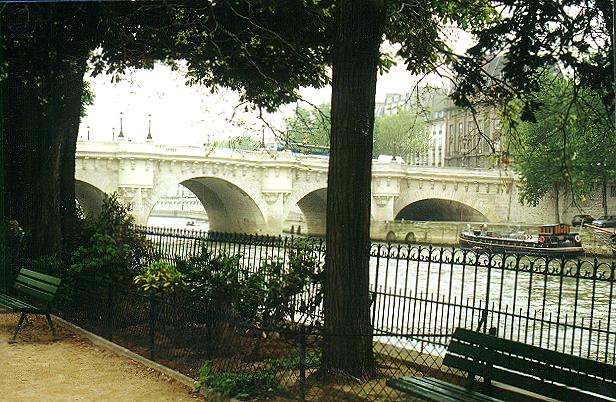
Hemingway described the place in A Moveable Feast:
"At the head of the Île de la Cité below the Pont Neuf where there was the statue of Henri Quatre, the island ended in a point like the sharp bow of a ship and there was a small park at the water's edge with fine chestnut trees, huge and spreading...."
I sat down on one of the benches and unzipped my daypack and got out the bread and cheese and the bottle of red wine and took out my Swiss Army snickersnee and proceeded to have my lunch, there under the fine chestnut trees which did indeed help break the chilly wind that was still blowing. Since the wind was out of the northwest, the northwest-pointing tip of an island in the middle of the Seine was perhaps not the most logical spot for a picnic that particular day, but I didn't care. If nothing else, it was the one place in Paris where you could dine amid literary associations without getting charged for it.
And despite the weather, it was a pleasant place to be, very quiet and peaceful - I had the little park to myself except for a young couple off at the far end, and like all Paris couples they were in their own world - with a splendid view of the river and, upstream on the right, the enormous sprawling mass of the Louvre. The wine was cheap ordinary plonk and the cheese was pretty mediocre stuff - I hadn't learned, yet, how to buy cheese in France - and the baguette had absorbed a little bit of moisture from the air, but still it was a good meal. Certainly the best I'd had so far today; breakfast was something I didn't want to think about.
(I had, I'm afraid, made the mistake of having le petit-dejeuner at the hotel - and it had been, as I should have expected, a ripoff: a few chunks of bread, a little bit of butter and a littler bit of jam in sealed packets, and a small pot of execrable coffee. I wasn't expecting the coffee to be very good - I had already begun to learn that the French simply do not have a clue how to make decent coffee - but the hotel coffee wasn't even decently hot, about the temperature of fresh pee and approximately as appetizing. A minor lesson learned - but maybe that was one reason lunch tasted good to me.)
I finished off the cheese, threw the leftover bits of bread to the pigeons and sparrows that clustered around my bench, drank a bit too much wine, and decided this wasn't such a bad day after all. A little while later I thumped the cork back into the half-full bottle, put it back in my daypack, and headed on downstream.
Next: Paris, Day Two, Part Two
Previous Page: Paris, Day One
Travel Home Page & Contents
Author's Home Site














